
Why Are Households Saving so much During the Corona Recession?
Savings rates among European households have reached record levels during the Corona recession. We investigate three possible explanations for the increase in household savings: precautionary motivations induced by increased economic uncertainty, reduced consumption opportunities due to lockdown measures, and Ricardian Equivalence, i.e. increases in the expected future tax-burden of households driven by increases in government debt. To test these explanations, we compile a monthly panel of euro area countries from January 2019 to August 2020. Our findings indicate that the chief driver of the increase in household savings is supply: As governments restrict households’ opportunities to spend, households spend less. We estimate that going from no lockdown measures to that of Italy’s in March, would have resulted in the growth of Germany’s deposit to Gross Domestic Product (GDP) ratio being 0.6 percentage points higher each month. This would be equivalent to the volume of deposits increasing by roughly 14.3 billion euros or 348 euros per house monthly. Demand effects, driven by either fears of unemployment or fear of infection from COVID-19, appear to only have a weak impact on household savings, whereas changes in government debt are unrelated or even negatively related to savings rates. The analysis suggests that there is some pent-up demand for consumption that may unravel after lockdown measures are abolished and may result in a significant increase in consumption in the late spring/early summer 2021.
01. Februar 2021
Introduction
Savings rates among European households have reached record levels during the Corona recession (see Figure 1). Simultaneously, the average debt to GDP ratio of the euro area is expected to increase by 15% through 2020,1 although the degree to which this is driven by increased spending, as opposed to decreased tax receipts, varies substantially by country. The sharp rise in household savings rates appears high enough to completely offset the increase in government deficit spending at the aggregate, while firm savings rates remain largely unchanged, such that countries’ economy wide savings rates (private and public) are roughly unchanged relative to their pre-COVID-19 levels.
Understanding why households are saving so much is crucial for understanding how and when we should expect aggregate demand to return to pre-COVID-19 levels. In this note, we propose three explanations for the sharp rise in savings and assess their ability to explain variation in household savings across European countries.
Perhaps the most obvious explanation for the increase in savings is reduced consumption opportunities related to lockdown measures. By shutting down restaurants, discouraging travel, and limiting retail capacity, governments reduced consumers’ opportunities to spend. While consumers may substitute these lost consumption opportunities with online spending, many may prefer to bide their time until they can travel or eat out again. This explanation can be thought as the supply hypothesis as, under this explanation, the decline in household consumption is not driven by demand. If households were unable to spend, a relaxation of measures may then result in a strong, perhaps short-lived consumption boom in the spring/summer of 2021. Especially those sectors that particularly suffered during the lockdown (tourism, restaurants, retail stores) would benefit.
Another intuitive explanation is that the increase in savings is driven by a decline in household demand. Fears of future employment income losses associated with increased economic uncertainty may have driven households to accumulate precautionary savings. It is well established in the theoretical and empirical literature that economic uncertainty associated with recessions drives households to reduce consumption.2 This explanation would tie a recovery in consumption to the economic recovery: To the extent that economic uncertainty persists even after lockdown measures have been phased out and adjustments to economic preferences due to Corona imply substantial structural adjustments, we would expect the recovery in consumption to be weak in 2021.
The third explanation is related to the sharp increase in deficit spending associated with the fiscal response packages to the recession. As households are forward looking, debt-financed increases in government spending may induce households to save in anticipation of future tax hikes to pay off the government’s debt. In the academic literature, this is known as Ricardian Equivalence.3 If households are worried about future tax payments, the increase in savings will persist until governments substantially reduce their deficits and debt levels. Hence, the recovery in consumption in 2021 can be expected to be weak based on this explanation as well.
In the cross-sectional data, we observe a relationship that appears to be consistent with Ricardian Equivalence (see Figures 1 and 2). In other words, countries where the government is running a higher deficit also happen to be countries where households are saving more.
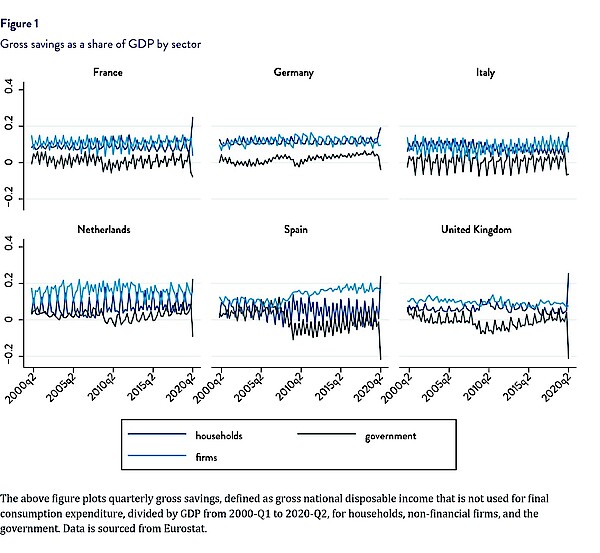
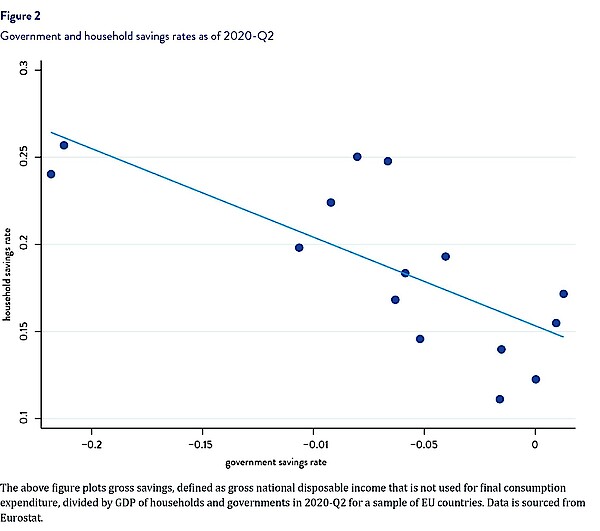
An alternative interpretation of Figure 2 is, however, that causality runs in the other direction: As households reduced spending due to lockdown measures and uncertainty, governments increased spending to offset this shortfall. Moreover, the reduction in household spending reduces tax revenue, mechanically resulting in a negative relationship. However, this could only explain at most one third of the relationship, as according to the OECD’s Global Revenue Statistics Database, on average, 33.7% of eurozone governments’ revenue is sourced from consumption based taxes. The extent to which each of these hypotheses can explain the increase in savings has profound implications for government policy and the economic recovery. If households only increased savings due to reduced consumption opportunities, pent up consumer demand could come roaring back as soon as governments decide it is safe to ease lockdown measures. Accordingly, too much government spending under such circumstances could lead to inflation if it continues after lockdown measures are removed. On the other hand, the extent to which rising savings are driven by precautionary motivations, the greater importance of assuring households that their employment is secure through countercyclical spending. Here, too little government spending could result in a vicious cycle of weak demand. However, if Ricardian Equivalence is the most prominent driver of increased household savings, then increasing fiscal rescue packages may only worsen aggregate demand shortfalls by increasing households’ expected future tax burdens.
We find no evidence that households reduced consumption to save for future taxes. If anything, the relationship is the reverse, as the coefficient on government debt on household savings is negative, although insignificant. Moreover, fear of unemployment and the severity of the virus appear to only explain a small share of the variation in savings rates. The most important driver of increased savings appears to be government lockdowns.
Our analysis suggests that the recovery in aggregate consumption will be rapid once mobility restrictions are suspended. It is possible and perhaps even likely that post-COVID-19 demand will temporarily exceed pre-COVID-19 levels as consumers return to normalcy with record levels of deposits. In contrast to the financial crisis, which severely dented households’ housing wealth in many countries, this time households will, on average, exit the crisis with more wealth than they had going into the crisis.
The relatively weak or non-existent importance of unemployment expectations in explaining variations in deposits stands in contrast to the results of Mody, Ohnsorge, and Sandri (2012) for the Great Recession, who find that labour income uncertainty drives two-fifths of the increase in savings in advanced economies. Consistent with our results, Dossche and Zlatanos (2020)4 find that while unemployment expectations drive a sizable share of the variation in savings in the past, it is unable to explain the recent rise in savings during the Corona recession.
Data and Summary Statistics
We compile a monthly panel of eurozone countries from January 2019 to August 2020 to measure the extent to which precautionary savings, reduced consumption opportunities, and Ricardian Equivalence can explain the rise in household savings. Because savings rates are only available at the quarterly level, we use monthly household deposits from the European Central Bank’s (ECB) Statistical Data Warehouse as a proxy that we then seasonally adjust.
While households can increase net savings by investing, reducing their debt, or holding currency, deposits should capture the majority of month-to-month changes in savings and are conveniently available on a monthly frequency for euro area members. Dossche and Zlatanos (2020) show that while currency in circulation has increased and household debt has declined, by far the most important driver of the increase in savings rates is household deposits.5
We measure government lockdown stringency using the Oxford COVID-19 Government Response Tracker (OxCGRT), which tracks comparable policy measures of government COVID-19 response measures across countries and time from January 2020 to today.6 We take the monthly average of all nine containment and closure policies by country and divide this value by the sample maximum, such that the country-month observation with the strictest set of containment policies equals one. We assign all observations prior January 2020 a lockdown stringency value of zero.
To capture variation in precautionary motivations for savings, similar to the approach of Dossche and Zlatanos (2020), we retrieve the seasonally adjusted households’ self-reported unemployment expectations over the next twelve months from the European Commission’s Consumer Survey Questionnaire. The index varies from –100 to +100 with a long-run average of 0. We argue that such a measure should be superior to using the realised level of unemployment for capturing precautionary motivations, as it captures households’ expectations about the future, which should be more important in explaining consumption and savings behaviour today.
We capture variation in the growth rate of government debt using total government debt securities divided by GDP. Total government debt securities are sourced from the ECB Statistical Data Warehouse. Using debt securities systematically underestimates the total level of debt in countries which rely on sources of financing beyond government bonds. However, over this period, there have been no international bailout loans to national eurozone governments that would not be captured by debt securities, so there should be little mismeasurement of changes in government debt for our sample.
Our sample consists of all eurozone members with populations greater than one million. All time series variables are seasonally adjusted using X-12-ARIMA. The sample period runs from January 2019 to August 2020, yielding 257 country-month observations with non-missing values for all variables.
Table 1 presents summary statistics for our sample. Both the stringency measure and death per million are strongly rightward skewed in their distribution, as the sample period covers at least 13 months of times before the COVID-19 crisis arrived in Europe.
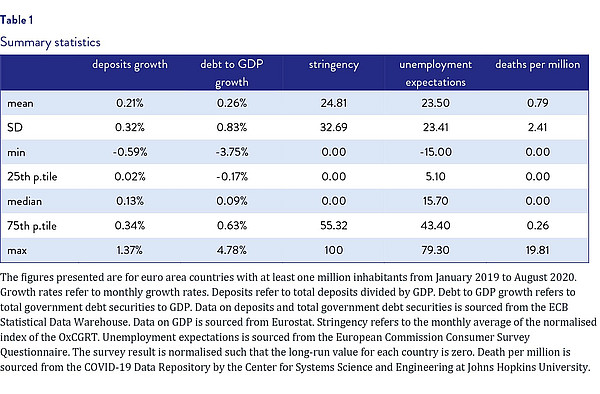
Table 2 displays pairwise correlations of the various variables included in the model. Straightaway, we observe that the variable most correlated with the deposit rate growth is the lockdown stringency index, followed closely by unemployment expectations. Moreover, the highest pairwise correlation of variables in the table is between the stringency index and unemployment expectations, perhaps reflecting both the impact of the lockdown on economic activity, but also the lockdown’s importance in forming households perceptions. Interestingly, we observe that the correlation between unemployment expectations and the stringency measure is greater than that of unemployment expectations and GDP growth. This could suggest that the lockdown may be more salient in forming the public’s perception of changes in economic activity than actual changes in economic activity.
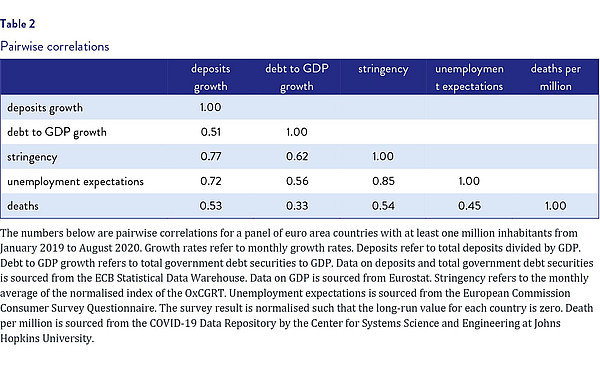
Results
Table 3 presents our results with different levels of fixed effects for the following regression model:
ΔDepositsi,t = β0 + β1Stringencyi,t + β2ΔGovDebti,t + β3E[U]i,t + ωt + δi + ϵi,t
where ΔDepositsi,t refers refers to the monthly growth rate of in the household deposit share in country i at time t, Stringencyi,t refers to the monthly average of the government mobility restrictions index from OxCGRT in country i at time t, ΔGovDebti,t refers to the level of government debt, E[U]i,t refers to employment expectations of households at time t in country i, ωt capture monthly time fixed effects, δi captures country fixed effects and ϵi,t refers to the error term, which we cluster at the country-level.
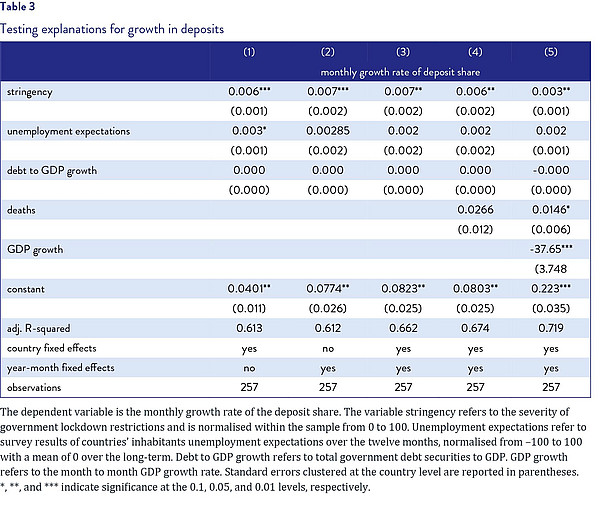
The coefficient on the index of government lockdown stringency is relatively consistent across various fixed effects specification, ranging from approximately 0.006 to 0.007 in our preferred specifications. Because the stringency index is normalised from 0 to 100, this implies that, on average, an increase from its minimum to its maximum results in the monthly deposit share growth rate being 0.6 percentage points higher – equivalent to two standard deviations. To put this magnitude in more concrete terms, had Germany gone from no restrictions to that of the level observed in Italy in March 2020, this would be equivalent to Germany’s deposits increasing by roughly 14.3 billion euros – or approximately 348 euros per household every month.
One concern may be that the coefficient on lockdown severity is upward biased by the severity of COVID-19. Households may fear that shopping, eating out, or travelling exposes them to an increased risk of infection, inducing them to avoid consumption opportunities. One would also expect that COVID-19 severity should be positively correlated with lockdowns as governments respond to the increased threat of the virus. To address this concern, in Column 4, we control for COVID-19 severity by including total monthly COVID-19 deaths per one million inhabitants sourced from the COVID-19 Data Repository by the Center for Systems Science and Engineering at Johns Hopkins University in the regression model. We find a coefficient on monthly deaths that is not quite statistically significant at the 10% level. Importantly, the coefficient on lockdown stringency is only marginally reduced in this specification relative to in columns 1 through 3.
Finally, in column 5, we include GDP growth in the model to ensure the relationship in the deposit share is not simply driven by the effect of lockdown stringency on GDP, which in turn impacts consumer confidence and thereby consumption. These results should be interpreted with caution as GDP growth should be subject to reverse causality with respect to deposits, as a decline in demand should also result in lower GDP growth. Here the magnitude of the impact of the lockdown is reduced from approximately 0.007 to 0.004. However, even if the lockdown drives deposits in part via its impact on GDP growth, this still would point to the lockdown as the root source driving the rise in the deposit share. Moreover, GDP growth may simply be capturing some of the variation in the severity of the lockdown. Hence, while this provides evidence that there is indeed a direct effect of the lockdown on deposits, it is unclear how to interpret the decline in the magnitude of the coefficient on lockdowns.
We find that the relationship between unemployment expectations and deposits is weak or inexistent. Only without time fixed do we observe a relationship that is statistically significant at the 10% level.
We also find no statistically significant relationship between government debt and changes in the deposit share in a panel setting. The cross-sectional relationship between the two perhaps reflects the fact that places more severely hit by the virus also happen to be places with stricter lockdown regimes and a greater need for a government fiscal response. In other tests (not shown), we find that the relationship between government debt and deposits vanishes once we control for time fixed effects, country fixed effects, lockdown regimes, or any combination of the three. This is reassuring from a policymaking perspective, because it suggests that there is currently no trade-off between aggregate demand and government spending.
Discussion
We construct a monthly panel of eurozone members and assess the ability of precautionary motivations, mobility restrictions, and government debt to explain the recent increase in household savings. We find strong evidence for the importance of lockdowns in explaining savings, weak evidence of precautionary motivations, and no evidence that this rise is explained by increasing government debt.
We interpret our results as being optimistic for the COVID-19 recovery. Unemployment expectations can take years to recover, as was the case in the Great Recession. Government debt levels can take even longer to return to pre-recession levels. However, lockdowns can quickly cease once a critical share of the population is vaccinated. The fact that households will, on average, exit the crisis with more wealth than they had going into the crisis should bode well for the recovery of consumer confidence and for financial stability more generally.
Some have raised concerns that post-COVID-19 spending could be too much of a good thing and that economies could be faced with inflation rates in the two-digits in the coming years.7 We view these concerns as overstated, even if inflation in excess of the ECB’s target is a real possibility. According the ECB, professional forecasters anticipate a five-year average inflation rate of just 1.7%8 and market expectations implied by five-year swap rates are at just 1%.9 Should European governments be faced with inflation following the easing of the lockdown, they can quickly scale back emergency fiscal rescue spending, and this is without mentioning the tools at the ECB’s disposal. Finally, for struggling firms with little pricing power, a temporary bout of inflation slightly above the ECB’s target of 2% may even be a welcome development.
Moreover, it is still uncertain to what extent households will spend their newly accumulated wealth as soon as mobility-restrictions are removed. Many may simply return to their pre-COVID-19 consumption habits, using the wealth for retirement or to eventually purchase a first home, all of which would bode well for financial stability in the long run.
In any case, at present, deflation seems to be the more immediate threat. The moving twelve-month average inflation rate for the euro area in October was a measly 0.5% and is even negative in five euro area countries.10 Deflation could further incentivise households to refrain from spending and with lockdowns in place, there is little room for fiscal and monetary policy to induce more demand if people do not have opportunities to spend.
Our results do not find any evidence that there is currently a tradeoff between government spending and aggregate demand. Indeed, while we do not find that precautionary savings play a large role in the increase in the deposit share, this would perhaps be different had governments played a more subdued role in mitigating the economic burden of the COVID-19 crisis.
Finally, our data does not incorporate the more recent lockdowns implemented in November and December across the eurozone in response to the “second wave” of COVID-19 cases. In general, there is little reason to think that the recent lockdown had a different effect from the earlier one, given that consumption possibilities were similarly restricted as before with stores closed, mobility restrictions increased, and restaurants limited to takeout, etc.
Endnoten
1 See Micossi, S.: Managing Post-Covid Sovereign Debts in the Euro Area, in: VoxEU, https://voxeu.org/article/managing-post-covid-sovereign-debts-euro-area, 2020.
2 See Damar, H. E.; Gropp R. E.; Mordel, A.: Banks' Funding Stress, Lending Supply, and Consumption Expenditure, in: Journal of Money, Credit and Banking, Vol. 52 (4), 2020, 685-720. – Leland, H. E.: Saving and Uncertainty: The Precautionary Demand for Saving, in: Quarterly Review of Economics, Vol. 82 (3), 1968, 465–473. – Mody, A.; Ohnsorge, F.; Sandri, D.: Precautionary Savings in the Great Recession, in: IMF Economic Review, Vol. 80 (1), 2012, 114-138.
3 See Barro, R.: Are Government Bonds Net Wealth, in: Journal of Political Economy, Vol. 82 (6), 1974, 1095-1117.
4 See Dossche, M.; Zlatanos, S.: COVID-19 and the Increase in Household Savings: Precautionary or Forced?, in: ECB Economic Bulletin, Iss. 6/2020, 2020
5 If households had spent as before, household deposits would have remained unchanged, while firm deposits would have increased.
6 If policies vary at regional level, the index measures the stringency of the strictest region of the country. Policy indicators included capture restrictions and recommendations with respect to work places, public events, public transport, schools, international travel, internal movement, and stay at home orders.
7 See www.focus.de/finanzen/boerse/geldanlage/notenbanken-bleibt-kein-ausweg-top-oekonom-hans-werner-sinn-hofft-dass-inflation-nicht-so-schlimm-wie-nach-dem-weltkrieg-wird_id_12732332.html, www.wiwo.de/my/politik/konjunktur/treibt-corona-die-inflation-ja-nach-der-krise-kommt-die-inflation-mit-macht/25845292.html, www.focus.de/finanzen/boerse/interview-mit-hendrik-leber-finanz-profi-ich-rechne-mit-zweistelligen-inflationsraten_id_12647760.html.
8 See www.ecb.europa.eu/stats/ecb_surveys/survey_of_professional_forecasters/html/table_hist_hicp.en.html.
9 See www.economist.com/briefing/2020/12/12/a-surge-in-inflation-looks-unlikely.
10 Source: Eurostat.





